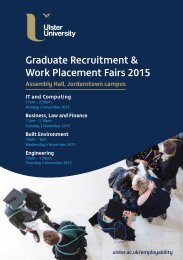Public Attitudes to Peace Walls (2015)
1RRkqqy
1RRkqqy
You also want an ePaper? Increase the reach of your titles
YUMPU automatically turns print PDFs into web optimized ePapers that Google loves.
<strong>Public</strong> <strong>Attitudes</strong> <strong>to</strong> <strong>Peace</strong> <strong>Walls</strong> (<strong>2015</strong>)<br />
Survey Results<br />
Ulster University<br />
4. Key Findings<br />
This is the second independent survey looking at public awareness and attitudes <strong>to</strong>wards peace<br />
walls in Northern Ireland. Aside from adding <strong>to</strong> existing quantitative research and increasing the<br />
body of knowledge, we are now in a better position <strong>to</strong> explore whether there have been changes<br />
in the views and attitudes of those living closest <strong>to</strong> the peace walls.<br />
The following section draws <strong>to</strong>gether the key findings from the <strong>2015</strong> edition of the survey under<br />
three headings: the most relevant views and attitudes of all residents <strong>to</strong>wards the peace walls; the<br />
views and attitudes of residents disaggregated <strong>to</strong> show differences by religion; and variations in<br />
the views and attitudes between the 2012 and <strong>2015</strong> editions of this survey.<br />
4.1 Views and attitudes of residents<br />
41% could envisage a time when there would be no peace walls and 41% could not.<br />
Catholics were more optimistic about this than Protestants [table 27]<br />
76% feel ‘very safe’ or ‘fairly safe’ in their community, while less that 10% feel unsafe<br />
[table 7]<br />
48% would be ‘very worried’ or ‘fairly worried’ about the ability of the police <strong>to</strong><br />
maintain order if their nearest peace wall was removed, rising <strong>to</strong> 61% among<br />
Protestants [table 23]<br />
50% interact with people outside of their own community background ‘very often’ or<br />
‘often’ [table 8]<br />
79% report that their interaction with other communities is positive and only 3%<br />
described it as negative [table 9]<br />
22% interact with people from the immediate community on the other side of the<br />
wall. 42% have no contact with the community across the wall [table10a]<br />
41% would go <strong>to</strong> their local community representative if they had a ‘question’ or<br />
‘issue’ about their nearest peace wall, compared <strong>to</strong> 14% <strong>to</strong> the local council and 11%<br />
<strong>to</strong> the police [table 15]<br />
43% would expect <strong>to</strong> be kept informed about developments relating <strong>to</strong> the peace<br />
wall by local community representatives, compared <strong>to</strong> 20% expecting information<br />
from Councils and 16% from elected representatives [table 18]<br />
38% of residents believe that community consent means everybody in the<br />
community [table 20]<br />
28




